Books and Book Reviews
Women at the center of climate friendly approaches to agriculture and water use - A report by the Institute for Agriculture and Trade Policy
Posted on 17 Jun, 2011 10:45 AM The Institute for Agriculture and Trade Policy draws on the experiences of the Tamilnadu Women’s Collective (WC), a state-level federation of women’s groups from 1,500 villages, in the context where communities all around the world are struggling to find ways to cope with changes affecting food and water security because of the phenomenon of climate change.
The report argues that many a times, new food and water security policies at the national and international level tend to be narrow, look at each of these issues in isolation and undermine food and water security strategies adopted by individuals and households from marginal groups. Adaptation strategies to address food security focus almost exclusively on increasing agricultural production, while ignoring health and cultural aspects of the food being produced, and the role of agriculture as a means for rural viability.
Independent water regulatory authorities in India - Analysis and interventions - A compendium of analytical work by PRAYAS
Posted on 16 Jun, 2011 08:09 PMThese reforms have led to the establishment of Independent Regulatory Authorities (IRAs) in the water sector through the enactment of laws at the state level.
Reservoir fisheries of India - FAO technical paper (1995)
Posted on 08 Jun, 2011 05:49 PMThis desk review is directed at those engaged in research, education, development and planning and provides consolidated information on reservoirs, including the resources available, level of technologies and the extent of their utilisation and has attempted to systematically compile all relevant information on Indian reservoirs from a fisheries perspective.
Planning for vulnerability - The hazards and setbacks in coastal legislation – A report by Dakshin Foundation
Posted on 22 May, 2011 06:16 PM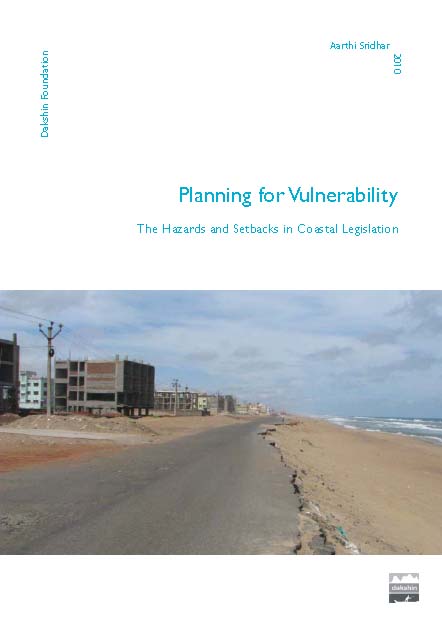 The law pertaining to coastal spaces – the Coastal Regulation Zone (CRZ) Notification, 1991 specifically decides what people can and cannot do on the coastal stretches of the country.
The law pertaining to coastal spaces – the Coastal Regulation Zone (CRZ) Notification, 1991 specifically decides what people can and cannot do on the coastal stretches of the country.
Harbouring trouble - The social and environmental upshot of port growth in India – A report by Dakshin Foundation
Posted on 22 May, 2011 12:04 PMBesides its own impact, port development is often accompanied by other activities such as the location of industries, power plants, railway lines, highways, hotels, SEZs, residential complexes, etc., that have multiple detrimental impacts – environmental, social and erosion related.
Claims for survival - Coastal land rights of fishing communities – A report by Dakshin Foundation
Posted on 22 May, 2011 09:25 AM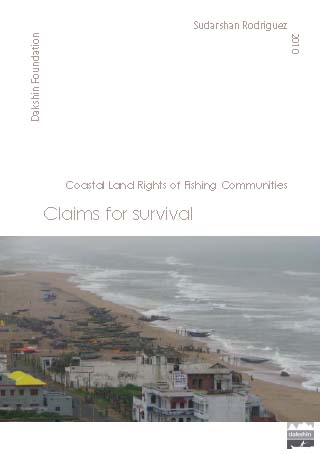 Marine-coastal ecosystems and coastal communities are poorly represented in the public debates on India’s social and environmental problems. Coastal and marine ecosystems are the backbone of a fisheries economy that supports livelihoods of millions directly and several more indirectly.
Marine-coastal ecosystems and coastal communities are poorly represented in the public debates on India’s social and environmental problems. Coastal and marine ecosystems are the backbone of a fisheries economy that supports livelihoods of millions directly and several more indirectly.
Community groups such as fishers and other coastal populations enjoyed customary or traditional rights to exploit resources and to fish in adjacent coastal areas. The current state of fisheries finds its genesis in the modernization programme introduced by the Government of India to ‘develop’ the sector with the focus for development through the maximisation of production. In the late 1970s, modern fishing methods threatened the livelihoods of these communities and coastal ecosystems. Mechanised craft and gear, principally trawlers with bottom trawling gear, severely impacted fishing stocks.
Fisherfolk in India have struggled for greater control over the seas and resource management, struggles which have been directed both inward as well as against the State. The conflict over the coastal space is mostly between fishing communities and other new users and interest groups. Access to coastal resources is now being thrown open to all, giving a new meaning to the idea of ‘coastal commons’. There are very clear linkages between the rights to the coast and the right to fish as without the former, the latter will be difficult to operationalise and eventually rendered meaningless.
The Coastal Regulation Zone (CRZ) Notification, 1991 has been the only legislation with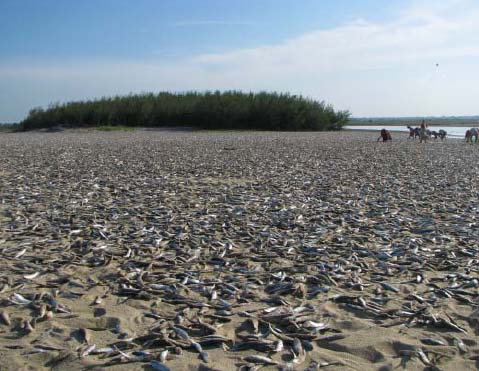 some mention and reference to customary rights of fishing communities on land in the coastal zone. However, it did not contain provisions and details to ascertain or establish these rights. Despite this, fishing communities have seen the CRZ in its 1991 form as an instrument in their favour as it regulates all activities that can potentially impact the coast and community livelihoods. However, the twenty one odd amendments to the CRZ Notification were mostly in favour of development pressures and special interest lobbies.
some mention and reference to customary rights of fishing communities on land in the coastal zone. However, it did not contain provisions and details to ascertain or establish these rights. Despite this, fishing communities have seen the CRZ in its 1991 form as an instrument in their favour as it regulates all activities that can potentially impact the coast and community livelihoods. However, the twenty one odd amendments to the CRZ Notification were mostly in favour of development pressures and special interest lobbies.
This backdrop forms the driving force behind this report which seeks to argue a case for according coastal land rights to fishing communities.
Changes in extreme rainfall events and flood risk in India during the last century- A report by the India Meteorological Department
Posted on 21 May, 2011 05:53 PM The occurrences of some exceptionally heavy rainfall during the recent years causing flash floods in many areas necessitated the study of long term changes in extreme rainfall over India.
The occurrences of some exceptionally heavy rainfall during the recent years causing flash floods in many areas necessitated the study of long term changes in extreme rainfall over India.
The study includes the analysis of the frequency of rainy days, number of rainy days and heavy rainfall days as well as one-day extreme rainfall and return period analysis in order to observe the impact of climate change on extreme weather events and flood risk. It has been found that frequency of heavy rainfall events are decreasing in major parts of the central and north India while increasing in peninsular India, east and north east India.
The report provides interesting findings that are useful for hydrological planning and disaster managements such as –
Monitoring system for incentive programs – Learning from large-scale rural sanitation initiatives in India – A report by the Water and Sanitation Programme
Posted on 21 May, 2011 02:15 PM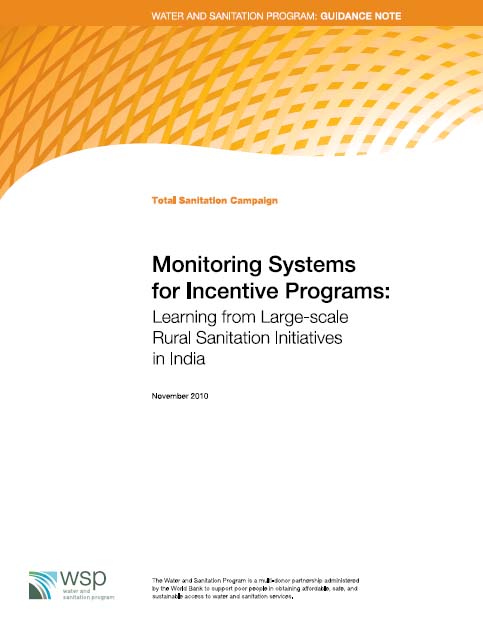 It is a part of the Global Scaling Up Rural Sanitation project of the Water and Sanitation Programme, World Bank and focuses on learning how to combine the approaches of Community Led Total Sanitation (CLTS), behavior change communications, and social marketing of sanitation to generate sanitation demand and strengthen the supply of sanitation products and services at scale, leading to improved health for people in rural areas. This is one in a series of knowledge products designed to showcase project findings, assessments and lessons learned in the project.
It is a part of the Global Scaling Up Rural Sanitation project of the Water and Sanitation Programme, World Bank and focuses on learning how to combine the approaches of Community Led Total Sanitation (CLTS), behavior change communications, and social marketing of sanitation to generate sanitation demand and strengthen the supply of sanitation products and services at scale, leading to improved health for people in rural areas. This is one in a series of knowledge products designed to showcase project findings, assessments and lessons learned in the project.
Over the last few years, the concept of open-defecation free communities has emerged as one of the building blocks toward achieving total sanitation. The term ‘access’ is widely used to capture increase in sanitation usage. However, a clean environment is a public good. Hence, there was a need to achieve total sanitation at the community level to realize public health benefits. This has led policy makers and practitioners to adopt strategies that achieve community-wide total sanitation status, which includes the community becoming open-defecation free, and adopting safe hygiene and environmental sanitation practices.
Bringing water to your door step - Urban water reforms for the next decade – A report by Price Waterhouse Coopers
Posted on 20 May, 2011 09:01 PM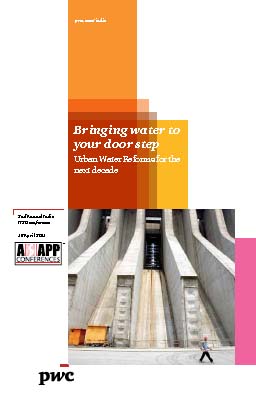 This report by Price Waterhouse Coopers India Limited for the Second Annual India Water Conference in April 2011 presents its view on urban water reforms for the next decade. India is still at an early stage of the urbanisation process and will witness exponential growth in many of its cities over the next few decades. By 2030 the urban population is expected to reach more than 590 million. This will put enormous pressure on all existing resources, especially water. Despite sufficient availability of raw water, many of its cities struggle to provide more than a few hours of water supply.
This report by Price Waterhouse Coopers India Limited for the Second Annual India Water Conference in April 2011 presents its view on urban water reforms for the next decade. India is still at an early stage of the urbanisation process and will witness exponential growth in many of its cities over the next few decades. By 2030 the urban population is expected to reach more than 590 million. This will put enormous pressure on all existing resources, especially water. Despite sufficient availability of raw water, many of its cities struggle to provide more than a few hours of water supply.
Improving water availability in the cities requires addressing complex policy, institutional and funding challenges. The core of the new approach will include instituting a new era of greater accountability and a performance-driven approach. Service delivery to urban poor has to be an integral part of this approach to bring about greater inclusiveness.
Recent experience with Public-Private-Partnerships (PPP) in urban water supply shows that with a customer focused approach and demonstration of clear benefits, there will be greater political and public acceptability of private participation. At the same time, fiscal framework at the local level has to be considerably strengthened before attempting wide scale replication of PPP.
Peri-urban water security in a context of urbanization and climate change - A review of concepts and relationships by SaciWaters
Posted on 17 May, 2011 04:05 PM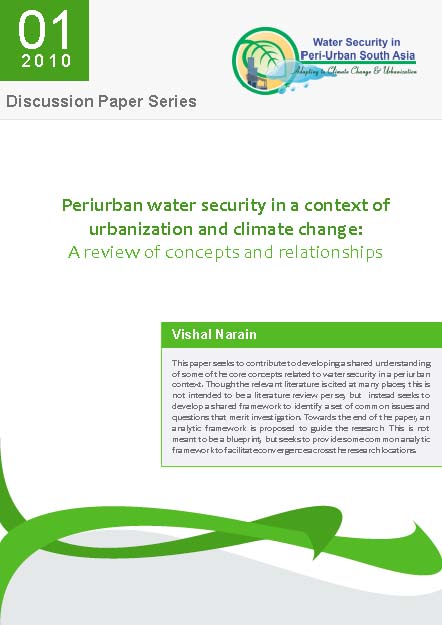
It is a part of the peri-urban water security project discussion paper series that aims at having a collection of research papers relevant to the concepts and processes involved in the project that represent preliminary ideas circulated to encourage discussion and comments.
Though the relevant literature is cited at many places, this is not intended to be a literature review per se, but instead seeks to develop a shared framework to identify a set of common issues and questions that merit investigation.
The paper argues that peri-urban can be better understood in terms of its characteristics - a mix of agricultural and non-agricultural land uses, flows of goods, services and resources between villages and urban centers and a social profile that is very heterogeneous and in a state of flux. All these impact upon the local natural resource base, creating particular environmental and natural resource management problems that are often beyond the scope of urban or rural governments alone and require innovative ways of being addressed.